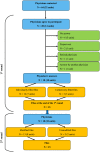Enhance quality care performance: Determination of the variables for establishing a common database in French paediatric critical care units
- PMID: 29987866
- PMCID: PMC6174952
- DOI: 10.1111/jep.12984
Enhance quality care performance: Determination of the variables for establishing a common database in French paediatric critical care units
Abstract
Selected variables for the French Paediatric Intensive Care registry.
Rationale, aims, and objectives: Providing quality care requires follow-up in regard to clinical and economic activities. Over the past decade, medical databases and patient registries have expanded considerably, particularly in paediatric critical care medicine (eg, the Paediatric Intensive Care Audit Network (PICANet) in the UK, the Australian and New Zealand Paediatric Intensive Care (ANZPIC) Registry in Australia and New Zealand, and the Virtual Paediatric Intensive Care Unit Performance System (VPS) in the USA). Such a registry is not yet available in France. The aim of this study was to determine variables that ought to be included in a French paediatric critical care registry.
Methods: Variables, items, and subitems from 3 foreign registries and 2 French local databases were used. Items described each variable, and subitems described items. The Delphi method was used to evaluate and rate 65 variables, 90 items, and 17 subitems taking into account importance or relevance based on input from 28 French physicians affiliated with the French Paediatric Critical Care Group. Two ratings were used between January and May 2013.
Results: Fifteen files from 10 paediatric intensive care units were included. Out of 65 potential variables, 48 (74%) were considered to be indispensable, 16 (25%) were considered to be optional, and 1 (2%) was considered to be irrelevant. Out of 90 potential items, 62 (69%) were considered to be relevant, 23 (26%) were considered to be of little relevance, and 5 (6%) were considered to be irrelevant. Out of 17 potential subitems, 9 (53%) were considered to be relevant, 6 (35%) were considered to be of little relevance, and 2 (12%) were considered to be irrelevant.
Conclusions: The necessary variables that ought to be included in a French paediatric critical care registry were identified. The challenge now is to develop the French registry for paediatric intensive care units.
Keywords: critical care; database; paediatrics.
© 2018 The Authors. Journal of Evaluation in Clinical Practice published by John Wiley & Sons Ltd.
References
-
- Dobb G, McWilliam D. Base de données: Méthodes et application In: Bion J, ed. Management en réanimation: Evaluation, organisation et éthique. Paris: Saulnier F; 2000:97‐111.
-
- LaRovere JM, Jeffries HE, Sachdeva RC, et al. Databases for assessing the outcomes of the treatment of patients with congenital and paediatric cardiac disease—the perspective of critical care. Cardiol Young. 2008;18(2):130‐136. - PubMed
-
- Slater A, Shann F, McEniery J. ANICS study group. The ANZPIC registry diagnostic codes: A system for coding reasons for admitting children to intensive care. Intensive Care Med. 2003;29(2):271‐277. - PubMed
MeSH terms
LinkOut - more resources
Full Text Sources
Other Literature Sources
Medical
Miscellaneous


